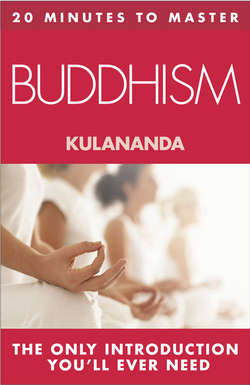Читать книгу 20 MINUTES TO MASTER … BUDDHISM - Kulananda - Страница 9
ОглавлениеINTRODUCTION
Over half the world’s population lives in countries which have been significantly influenced by Buddhist ideas and practices, yet from the time of the Buddha – half a millennium before the founding of Christianity – right up until the middle part of the twentieth century, the vast majority of Westerners knew almost nothing about it. Around the middle of the twentieth century, however, this began to change and Buddhism is now said to be the fastest growing religion in the West.
At a time when we are faced with a stark choice between the increasing demands of consumerism on the one hand, and religions which strain our credulity on the other, more and more men and women are turning to Buddhism as a way of discovering those human and spiritual values so lacking in the world today.
But what is Buddhism? We are used to thinking of religion as being somehow about a belief in God, in one or another of the many guises in which he is seen, but there is no God in Buddhism. Is it then simply a philosophy – a way of thinking about the world, or a way of leading a more ethical life? Or is it a kind of psychotherapy – a way of helping us to come to terms with ourselves and with the dilemmas which life constantly throws up? Buddhism contains all of these to some extent, but it is also very much more.
Buddhism asks us to reconsider our usual preconceptions of what is meant by religion. It deals with truths which go entirely beyond the merely rational, unfolding a transcendental vision of reality which altogether surpasses all our usual categories of thought. The Buddhist path is a way of spiritual training which leads, in time, to a direct, personal apprehension of that transcendental vision.
Every one of us has the capacity to be clearer, wiser, happier and freer than we currently are. We have the capacity to penetrate directly to the heart of reality – to come to know things as they really are. The teachings and methods of Buddhism ultimately have one goal alone: to enable us to fully realize that potential for ourselves.
Over the course of its long history, Buddhism spread to all the countries of Asia. Wherever it alighted, the interaction between the indigenous local culture and the newly arrived teachings of the Buddha wrought profound effects on both. In many cases Buddhism ignited a cultural renaissance. In some situations, as in Tibet, it was even the harbinger of culture. And as it moved, Buddhism too changed, adapting wherever it went to local cultural conditions. Thus, today, we have the Buddhisms of Sri Lanka, Thailand, Burma, Vietnam, Cambodia, Laos, Tibet, China, Mongolia, Russia and Japan; and within these a bewildering variety of schools, sects and sub-sects. Where in all this variety is Buddhism itself? What do all these different approaches have in common?
What they most have in common is their ancestral origin. They are all branches, leaves and flowers which have grown out from the trunk of early Indian Buddhism. They all look back to the Buddha and they all accept and propound the Buddha’s original teachings, although with very different emphases.
To understand the fundamentals of Buddhism, therefore, it is necessary to get back as close as we can to the Buddha himself. We can do this by looking into the earliest texts and seeing what they have to say for us today. This is not to reject later developments. Buddhists in the West today stand as heirs to the whole Buddhist tradition. We can admire, respect and make practical use of elements of Japanese Soto Zen as much as we can elements of Tibetan Vajrayana or Thai Theravada. But to understand the tradition as a whole we need to go back to its roots.
Most of the basic teachings in this book go back to early Indian Buddhism. I therefore hope that there is little here that Buddhists of different traditional allegiance would take issue with. For the same reason, I have generally confined myself to the early Indian canonical languages in the few cases where I need to describe Buddhist technical terms, using either Pali or Sanskrit as seems most appropriate in context. (This not being a scholarly work, I have omitted diacritical marks.)
The principal intention of this book is to introduce the general reader to the broad range of the Buddhist tradition by bringing out some of its most essential (and therefore most common) elements, and to show how the fundamental teachings of Buddhism have a significance which transcends their historical origins. Above all I hope it encourages some readers to try these out for themselves. Books are very useful, but if one really wants to know what Buddhism is about, one must try it out in practice. Even the most gifted writer cannot describe the flavour of an orange, and in the same way no book can ever capture the essence of Buddhist practice.
‘Just as the great ocean has one taste, the taste of salt,’ the Buddha said, ‘so my teaching has one flavour – the flavour of liberation.’
